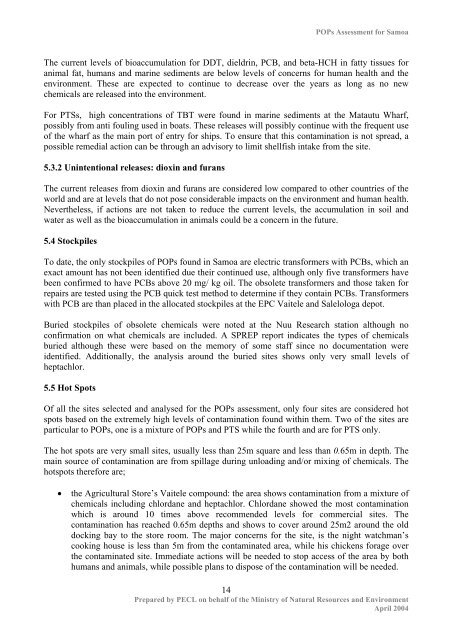Table of Content - SPREP
Table of Content - SPREP
Table of Content - SPREP
You also want an ePaper? Increase the reach of your titles
YUMPU automatically turns print PDFs into web optimized ePapers that Google loves.
POPs Assessment for Samoa<br />
The current levels <strong>of</strong> bioaccumulation for DDT, dieldrin, PCB, and beta-HCH in fatty tissues for<br />
animal fat, humans and marine sediments are below levels <strong>of</strong> concerns for human health and the<br />
environment. These are expected to continue to decrease over the years as long as no new<br />
chemicals are released into the environment.<br />
For PTSs, high concentrations <strong>of</strong> TBT were found in marine sediments at the Matautu Wharf,<br />
possibly from anti fouling used in boats. These releases will possibly continue with the frequent use<br />
<strong>of</strong> the wharf as the main port <strong>of</strong> entry for ships. To ensure that this contamination is not spread, a<br />
possible remedial action can be through an advisory to limit shellfish intake from the site.<br />
5.3.2 Unintentional releases: dioxin and furans<br />
The current releases from dioxin and furans are considered low compared to other countries <strong>of</strong> the<br />
world and are at levels that do not pose considerable impacts on the environment and human health.<br />
Nevertheless, if actions are not taken to reduce the current levels, the accumulation in soil and<br />
water as well as the bioaccumulation in animals could be a concern in the future.<br />
5.4 Stockpiles<br />
To date, the only stockpiles <strong>of</strong> POPs found in Samoa are electric transformers with PCBs, which an<br />
exact amount has not been identified due their continued use, although only five transformers have<br />
been confirmed to have PCBs above 20 mg/ kg oil. The obsolete transformers and those taken for<br />
repairs are tested using the PCB quick test method to determine if they contain PCBs. Transformers<br />
with PCB are than placed in the allocated stockpiles at the EPC Vaitele and Salelologa depot.<br />
Buried stockpiles <strong>of</strong> obsolete chemicals were noted at the Nuu Research station although no<br />
confirmation on what chemicals are included. A <strong>SPREP</strong> report indicates the types <strong>of</strong> chemicals<br />
buried although these were based on the memory <strong>of</strong> some staff since no documentation were<br />
identified. Additionally, the analysis around the buried sites shows only very small levels <strong>of</strong><br />
heptachlor.<br />
5.5 Hot Spots<br />
Of all the sites selected and analysed for the POPs assessment, only four sites are considered hot<br />
spots based on the extremely high levels <strong>of</strong> contamination found within them. Two <strong>of</strong> the sites are<br />
particular to POPs, one is a mixture <strong>of</strong> POPs and PTS while the fourth and are for PTS only.<br />
The hot spots are very small sites, usually less than 25m square and less than 0.65m in depth. The<br />
main source <strong>of</strong> contamination are from spillage during unloading and/or mixing <strong>of</strong> chemicals. The<br />
hotspots therefore are;<br />
• the Agricultural Store’s Vaitele compound: the area shows contamination from a mixture <strong>of</strong><br />
chemicals including chlordane and heptachlor. Chlordane showed the most contamination<br />
which is around 10 times above recommended levels for commercial sites. The<br />
contamination has reached 0.65m depths and shows to cover around 25m2 around the old<br />
docking bay to the store room. The major concerns for the site, is the night watchman’s<br />
cooking house is less than 5m from the contaminated area, while his chickens forage over<br />
the contaminated site. Immediate actions will be needed to stop access <strong>of</strong> the area by both<br />
humans and animals, while possible plans to dispose <strong>of</strong> the contamination will be needed.<br />
14<br />
Prepared by PECL on behalf <strong>of</strong> the Ministry <strong>of</strong> Natural Resources and Environment<br />
April 2004

















